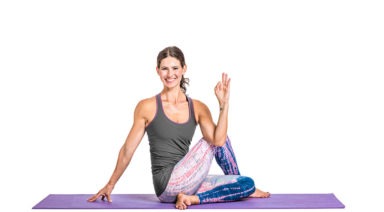Can’t sleep? 5 yoga poses to treat your insomnia

Insomnia is pure misery (there’s a reason sleep deprivation is a form of torture). Just sitting in the dark, feeling totally and completely exhausted but unable to fall asleep is like dying of thirst but unable to have a drink. However, if you’re tired of laying there night after night, there IS something you can do about your insomnia! Yoga for insomnia may be able to help you sleep better and sleep more deeply.
It should be noted that the causes of insomnia are complicated, and yoga isn’t going to be a cure-all for everyone who tries it. However, there are success stories; if you are desperate, it’s worth giving anything a try (especially something as healthy as yoga) in order to finally get a good night’s rest.
If you’re new to yoga, it might be in your best interest to try out a few classes and get some pointers before going it alone. These are definitely beginner’s poses, but making sure your body is properly aligned is the essential part of yoga, and you also don’t want to hurt yourself.
If you want to see the poses in action, click on the name of the pose!
1. Seated Forward Bend
How It Works: seeking calm and restoration? This is the pose for you. It also can help improve digestion. If digestive issues are keeping you up or waking you at night, this can help, big time.
How to Practice: Sit on the floor with your legs straight out in front of you, focusing on sitting up as straight as possible. Inhale, and raise your arms over your head, flexing your feet as you dive forward. Grab on to your feet, ankles, calves, or thighs. Don’t worry about how far you go. When you feel a gentle stretch in the backs of your legs, you’ve gone far enough to get the benefits of this pose. Keep your back as straight as you can, and stay here for 10-12 slow breaths.
2. Bridge Pose
How It Works: a back bend to help you sleep? It might not sound particularly relaxing, but it can actually help you calm down and prepare for sleep. Inversions like bridge pose alleviate stress, which is one of the major factors that can contribute to insomnia. Let’s face it, it’s your mind, not your body, keeping you up.
How to Practice: Start by lying on your back, then bend your knees, drawing your feet in, so that they’re flat on the floor right by your bottom. On your next inhale, press down with your feet and your arms to raise your bottom off of the floor. Use your inner thigh muscles to keep your legs from falling out to the sides, and clasp your hands together. Squeeze your shoulder blades together gently, and breathe in this posture for 10-15 slow breaths, then slowly release your back onto the floor.
3. Reclining Bound Angle Pose
How It Works: this is a relaxation pose that stretches your legs and reduces stress to help you sleep better and more deeply. It’s especially beneficial if racing thoughts or a restless body are keeping you awake.
How to Practice: Start in a seated position, with your feet touching each other. Lean back, so one elbow is on the floor, then lower yourself down so that your back is resting on the floor, and focus on rolling your shoulders back and pulling your shoulder blades together. Your arms should be in a neutral position, palms up, like in the photo. Close your eyes and breathe, staying in this posture for as long as you like. You can use a blanket or bolster to support your feet, like in the photo above, if necessary. You can also tuck pillows or folded blankets under your knees or thighs, if you feel like you need more support there.
4. Shoulder Stand
How It Works: a basic inversion like shoulder stand helps you slow down and relax. This posture calms the mind and relieves leg and foot soreness that might be robbing you of sleep.
How to Practice: Begin by lying on your back, then bring your knees into your chest. Place your arms flat on the floor, so that your hands extend past your bottom, palms on the floor. Push with your arms, and curl your spine to bring your legs straight up into the air. Bend your elbows, and place your hands on your lower back to support yourself in this posture. If you find shoulder stand too intense, try Legs Up the Wall instead. It’s a simpler variation with many of the same benefits.
5. Savasana
How It Works: This pose may not seem like much, but the practice of lying still and letting your body soak in the poses you just practiced helps prepare your brain for rest and relaxation.
How to Practice: Lie on your back with your feet shoulder-width apart and your arms in a neutral palms-up position by your sides. Close your eyes, and focus on your breath. Notice how your belly gently rises and falls as you inhale and exhale. There are quite a few technique that you can use while you’re in this pose. You can just focus on your breath, listen to soothing music, or choose a guided meditation to listen to.
Want more? Try our other yoga routines for sleep or these Ayurvedic tips for good sleep.
9 Yoga Poses for Relieving Shoulder Tension

Yoga, when practiced regularly, relaxes muscle tension and in the process, also strengthens the relaxed muscles. Here are a list of poses that will help relieve tension around the shoulder area:

1. BALASANA (CHILD’S POSE)
Child’s pose is a very good way to start a practice. It’s also an excellent rest pose during a vigorous flow.
Come to your hands and knees, press your hips back into your heels. Open your knees out toward the corner of your mat and rest your belly and chest between your thighs; arms out in front of you and palms up. Allow your shoulders to melt downward. This is a gentle way to start warming up the shoulders.

2. BHARADVAJASANA I (SEATED TWIST)
Sitting crossed legged, stretching your spine tall, place your left hand on your right knee and your right arm on the floor at your right hip. Draw a breath in and turn your shoulders and upper torso to the right.
The idea here is to stay gently grounded in the sits bones while extending the spine upward. If you’re twisting right, then ensure your left hip stays grounded. Lift as you inhale and turn as you exhale. Keep your gaze over your right shoulder. Try to keep your shoulders at the same height, and keep your neck soft. Your chin should be in neutral, but if you want an added stretch, you can tuck the chin. Hold for a few breaths, and then come back to center. Repeat on the left side.

3. SUPTA BADDHA KONASANA (RECLINING BOUND ANGLE POSE)
This pose offers a stretch across the chest and releases the shoulders.
Lying on your back, put a bolster or a block longways between your shoulder blades. Bring the soles of your feet together and allow your knees to fall open. If that is too intense, just leave the legs long and resting on the mat. Rest your arms by your sides. You will notice that if you turn your palms to face up, that will increase the rotation in the shoulders. You can either support your head or, if it feels good, allow your head to drop back (this will stimulate the thyroid).

4. PRASARITA PADOTTANASANA (WIDE-LEGGED FORWARD FOLD)
Standing with your legs wide, turn your toes inward slightly and heels out. Bring your hands to meet behind your back and interlace your fingers. If that is not accessible to you, hold a towel or a strap between your hands. With an inhale, lift your chest and roll your shoulders back, extending the hands backward. On the exhale bend forward, keeping a slight bend in your knees. Allow gravity to draw your hands over your head. This creates a lovely rotation in the shoulders. Hold this pose for at least eight breaths (inhales and exhales).

5. SETU BANDHASANA (BRIDGE POSE)
Lie down on your back and bend your knees, feet hip width apart and on the mat. As you breathe out, press your feet into the mat and raise your buttocks, lifting the sternum towards the chin. Elongate the back of the neck onto the floor and breathe deeply. Reach for your feet with your hands, while rolling on to your shoulders. Keep your head still with your nose pointing up and gently press the back of your head into the mat, all the while lifting the hips.
You have the option of supporting yourself with your hands under your hips, or on a block. As you breathe, and your body starts to open, try to walk your shoulders closer to each other and reach your hands towards your feet. This will help open the chest. Move your chest toward your chin. This pose is also great for calming the mind.

6. PASCHIMOTTANASANA (SUPPORTED FORWARD BEND)
This pose is meant to release and relax your neck. Sit on the floor in front of a chair. Place a pillow on the chair, and rest your head on the pillow with your arms just under your forehead. Gently stretch the neck muscles by dropping the chin to the chest. Breathe in and out while resting your head on the pillow.

7. GOMUKHASANA (COW FACE POSE)
When we sit in front of a computer we round our shoulders and push our chins forward. This pose is great for helping to correct our posture.
Sit up straight in a comfortable cross-legged seat. Lift your left arm straight up, palm turned inward and thumb pointing to the back of the room. Bend that arm and reach it down between the shoulder blades. Now extend your right arm to the side, thumb down and palm facing back. Bend the arm and bring the elbow in to the side and reach up between the shoulder blades. Take hold of the other hand. If this is a little hard, use a strap between the hands. Lift your heart and press into your sits bones. Keep your chin in neutral and the neck soft.

8. SAVASANA (CORPSE POSE)
This pose is often used in meditation with the intention of complete relaxation.
Lie on your back, arms by your sides. Spread your feet apart and allow them to drop open. Let your arms rest by your sides, palms up. Allow your fingers to curl up naturally. Lift your shoulders, broaden them and then let them melt into the mat as you exhale. Breathe with deep, smooth breaths.
Support your body where you need to. Sometimes a bolster under the knees, or between the shoulder blades feels good.

9. YOGA OFF THE MAT
In a seated position, come to the top of your sits bones and gently draw your belly in. Lift your heart and allow your shoulders to slide down your back. Keep your chin in neutral and allow for a good distance between the ears and shoulders. This is also a good posture to hold when you are standing or walking. Keep the tailbone gently tucked under.
Remember to keep moving your body. It is joyful, gives us energy and keeps us healthy.





































